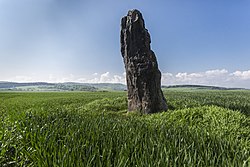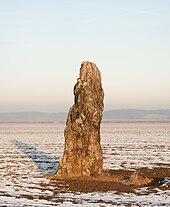Menhir from Benzingerode
| Menhir from Benzingerode Hünenstein, Hunnenstein, megalithic grave | ||
|---|---|---|
|
The Menhir of Benzingerode (2014) |
||
|
|
||
| Coordinates | 51 ° 50 '35.7 " N , 10 ° 52' 45.7" E | |
| place | Wernigerode , OT Benzingerode , Saxony-Anhalt , Germany | |
The menhir of Benzingerode (also known as Hünenstein , Hunnenstein or Hünengrab ) is a menhir near Benzingerode , a district of Wernigerode in the Harz district in Saxony-Anhalt . With a height of 3.85 meters, it is considered the highest prehistoric long stone (menhir) in northern Germany .
Location and description
The menhir is located northeast of Benzingerode just below the highest point of a hill known as a "stone field". It consists of senonian quartzite ; the next deposit is 1.5 km away at Heimburg . It has a height of 450 cm (385 cm above ground), a width of 160 cm and a depth of 60 cm. It is very fissured and tapers towards the top.
The area surrounding the menhir is very rich in prehistoric findings . Originally there were at least four other menhirs in its vicinity, two of which still exist today: the menhir from Heimburg and the menhir from Derenburg ; there is a visual axis to the latter. Between 1975 and 1983 over 600 ceramic shards were found during field inspections , ranging from linear ceramics through the Late Bronze and Iron Ages to the Middle Ages . In 2001 the Benzingerode shed , a collective grave of the Bernburg culture , was discovered during an emergency excavation .
In 1939 Alfred Tode carried out an excavation directly on the menhir. On the square excavation area with a side length of 8 m he found a west-east oriented stone packing grave , which did not contain any finds. Either the skeletal remains were simply not preserved here or the grave was designed as a cenotaph from the start . Other findings were a pit with remains of fire, a stone pavement directly at the foot of the stone and a late Roman urn grave in which resin, melted glass beads and remains of a bony comb were found. Gerhard Bosinski later determined that the ensemble of findings bears a great resemblance to the menhir from Einselthum in Rhineland-Palatinate , around which a fire pit, a stone pavement and an empty stone packing grave are also arranged.
The menhir in regional sagas
According to a legend , the menhir is said to be a memorial on the grave of a pagan hero who died in battle.
Another legend revolves around this and two other menhirs in the area. According to this, three giants were once in love with a peasant girl, and in order to decide who should get them, they wanted to throw stones from the Struvenburg . The oldest giant threw the largest stone, which remained upright in the field and which is said to be the menhir from Benzingerode. The second stone flew a little further, but got stuck at an angle in the soft ground. The youngest giant threw the smallest stone and threw it farthest. But when the giants realized that they had held an unequal competition, they parted in an argument and the peasant girl waited in vain for her suitor.
literature
- Hans-Jürgen Beier : The megalithic, submegalithic and pseudomegalithic buildings as well as the menhirs between the Baltic Sea and the Thuringian Forest. Contributions to the prehistory and early history of Central Europe 1. Wilkau-Haßlau 1991.
- Birgitt Berthold and others: Archeology in Saxony-Anhalt / Die Totenhütte von Benzingerode: Archeology and anthropology: special volume 7. Landesamt f. Monument preservation u. Archeology Saxony-Anhalt, 1st edition, Halle (Saale) 2008, ISBN 978-3-939414-12-4 , pp. 20-22.
- Gerhard Bosinski : The long stone near Einselthum (Palatinate). A menhir of the Rössen culture? In: Germania. Volume 39, 1961, pp. 181-185.
- Gisela Graichen : The cult place book. A guide to old sacrificial sites, shrines and places of worship in Germany. Hamburg 1990, pp. 344-347.
- Johannes Groht : Menhirs in Germany. State Office for Monument Preservation and Archeology Saxony-Anhalt, Halle (Saale) 2013, ISBN 978-3-943904-18-5 , pp. 25, 390–391, 445–446.
- Horst Kirchner: The menhirs in Central Europe and the menhir thought (= Academy of Sciences and Literature. Treatises of the humanities and social sciences class. Born 1955, No. 9). Wiesbaden 1955, p. 184.
- Johannes Pätzold: Investigations on the menhir of Benzingerode. In: Klaus Schwarz (Ed.): Strena Praehistorica. Ceremony for Martin Jahn's 60th birthday. Halle (Saale) 1948, pp. 78-89.
- Michael Schmidt: The old stones. Travel to the megalithic culture in Central Europe. Rostock 1998, pp. 93-94.
- Johannes Schneider: Soil monuments of the Magdeburg district. In: Annual journal for Central German Prehistory. Volume 69, 1986, pp. 103-131.
- Johannes Schneider: Benzingerode. In: Joachim Hermann (Hrsg.): Archeology in the German Democratic Republic. Monuments and finds. Volume 2, Urania, Leipzig / Jena / Berlin 1989, ISBN 3-332-00308-9 , p. 408.
- Waldtraut Schrickel : Western European elements in the Neolithic and the Early Bronze Age of Central Germany. Part I. Catalog. Publications of the State Museum for Prehistory Dresden, Volume 5, VEB Bibliographisches Institut, Leipzig 1957, p. 18.
- Britta Schulze-Thulin : Large stone graves and menhirs. Saxony-Anhalt • Thuringia • Saxony. 2nd Edition. Mitteldeutscher Verlag, Halle (Saale) 2011, ISBN 978-3-89812-799-8 , p. 76.
Web links
- Menhir from Benzingerode near Wernigerode
- Description in the Braunschweig-Ostfalen region
- Menhir from Benzingerode
- The three menhirs at Benzingerode, Derenburg and Heimburg in the Harz foreland
- The Benzigerode menhir and traces of the early Harz Mountains
Individual evidence
- ↑ Chris Bergmann: Harz. Hiking compact. Bruckman, 2004, ISBN 3-7654-3569-4 , pp. 22 .
- ↑ a b Johannes Groht: Menhirs in Germany. P. 445.
- ↑ Birgitt Berthold et al.: Die Totenhütte von Benzingerode. Pp. 20-21.
- ^ Johannes Schneider: Benzingerode. P. 408.
- ↑ Gerhard Bosinski: The long stone near Einselthum (Palatinate). A menhir of the Rössen culture? P. 183ff.
- ^ Waldtraut Schrickel: Western European elements in the Neolithic and in the early Bronze Age of Central Germany. Part I. Catalog. P. 18.
- ^ Johannes Groht: Menhirs in Germany. Pp. 445-446.


